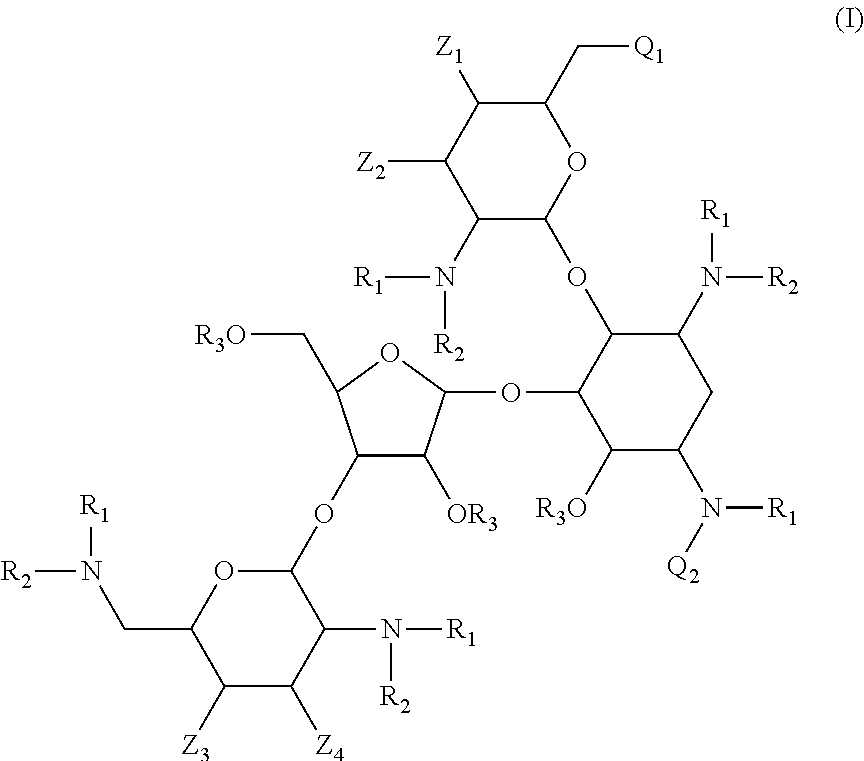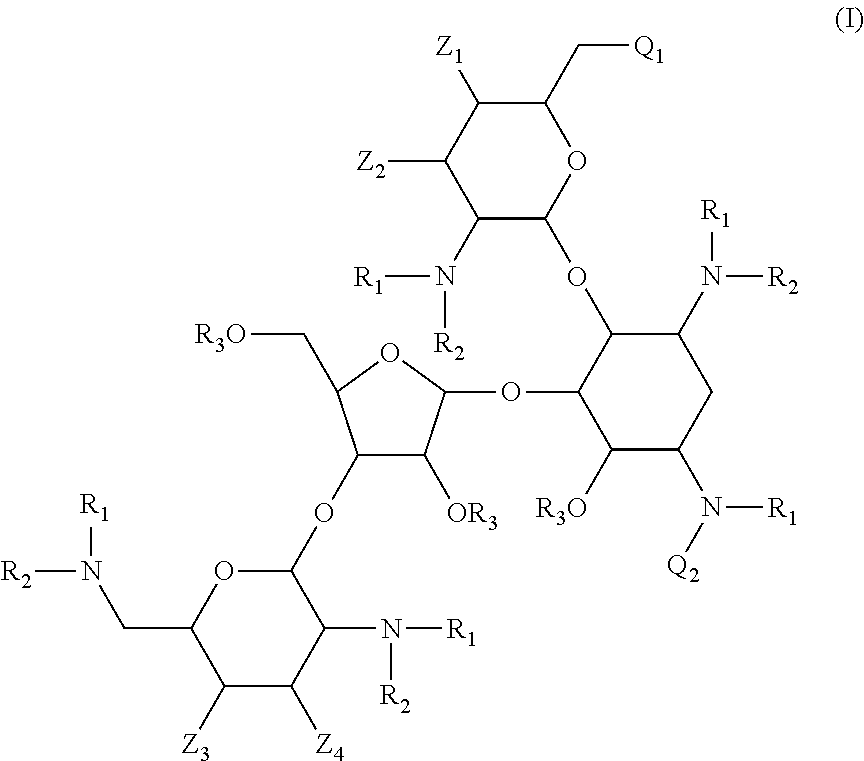Antibacterial aminoglycoside analogs
a technology of aminoglycosides and aminoglycosides, which is applied in the field of aminoglycoside compounds, can solve the problems of difficult purification of proteins, inability to remove single alpha helix or beta sheet and use it in drug screening, and major limitation of classical high throughput screening of biologically active proteins
- Summary
- Abstract
- Description
- Claims
- Application Information
AI Technical Summary
Benefits of technology
Problems solved by technology
Method used
Image
Examples
example 1
[0156]
[0157]To a stirring solution of (S)-4-(benzyloxycarbonylamino)-2-hydroxybutanoic acid (1, 612 g, 2.41 mol) in THF (6 L) at 0° C. was added DMAP (2.4 g) and pyridine (196 mL, 2.41 mol). After stirring for 20 minutes, benzoyl chloride (280 mL) was added slowly and the reaction was allowed to stir overnight at room temperature. The resulting precipitate was filtered and the filtrate was acidified with 1 M citric acid (1 L). The organic solvent was removed by rotary evaporation and the desired product was extracted with EtOAc (2×2 L). The combined organic layers were washed with 1 M citric acid (1 L), brine (1 L) and then dried over MgSO4. Solvent removal under vacuum resulted in a viscous oil, which was purified on a 6-inch reverse-phase HPLC column to yield (S)-2-(benzoyloxy)-4-(benzyloxycarbonylamino)butanoic acid (2) as a non-flowing viscous oil (439 g, 51% yield).
[0158]To a stirring solution of (S)-2-(benzoyloxy)-4-(benzyloxycarbonylamino)butanoic acid (2, 196 g, 0.548 mol) a...
example 2
[0170]
[0171]To a stirring solution of paromomycin sulfate (1, 76 g, 84 mmol) in water (209 mL) and tetrahydrofuran (1084 mL) at 0° C. was added a solution of sodium carbonate in water (254 mL, 218 mmol, 0.86 M), followed by the dropwise addition of benzyl chloroformate (120 mL, 840 mmol). Sodium bicarbonate (70.6 g, 840 mmol) was then added and the reaction was stirred for 3 hours. The two layers were separated and the organic layer was concentrated to a thick oil, which was diluted with ethyl acetate (400 mL) to give a total volume of 1.2 L. This was then dripped into hexane (9 L), and a precipitate formed. The filtrate was decanted off and concentrated to a white foam (2) (69.85 g, 64.5% yield).
[0172]To a stirring solution of (2) (69.85 g, 0.054 mmol) in 200 mL benzaldehyde was added 2 mL TFA dropwise. After stirring for 5.5 hours, the reaction solution was dripped into a vigorously stirred solution of 3.4 L of 3:2 Ether:Hexanes and the resulting slurry was allowed to stir overnig...
example 3
[0178]
[0179]Neomycin sulfate (1, 240 g, 391 mmol, 1 eq) was suspended in MeOH (10 L) then was diluted with H2O (400 mL). The reaction was cooled to 0° C. and K2CO3 (1080 g, 7818 mmol, 20 eq) was added slowly to the reaction mixture. Benzyl chloroformate (550 mL, 3910 mmol, 10 eq) was then added to the reaction mixture via a dropping funnel over 3 hours. The mixture was stirred vigorously for 18 hours at room temperature, then was filtered and concentrated to 2 L. The concentrate was diluted with ethyl acetate (2 L), washed with water (2×2 L), washed with brine (2 L), dried over Na2SO4 and concentrated to a yellow foam. The foam was dissolved in MeOH (1 L) and dripped into Et2O (24 L), and a precipitate was formed. The white solid was filtered off and dried under high vacuum to yield 410 g of crude, which was purified on a 6-inch reverse phase HPLC column to yield 1,3,2′,6′,2′″,6′″-hexa-Cbz-neomycin (2, 171 g, 31%). MS: m / z (M+Na)+ calc. 1441.53, obs. 1441.6.
[0180]1,3,2′,6′,2′″,6′″-H...
PUM
| Property | Measurement | Unit |
|---|---|---|
| total volume | aaaaa | aaaaa |
| temperature | aaaaa | aaaaa |
| volume | aaaaa | aaaaa |
Abstract
Description
Claims
Application Information
 Login to View More
Login to View More - R&D
- Intellectual Property
- Life Sciences
- Materials
- Tech Scout
- Unparalleled Data Quality
- Higher Quality Content
- 60% Fewer Hallucinations
Browse by: Latest US Patents, China's latest patents, Technical Efficacy Thesaurus, Application Domain, Technology Topic, Popular Technical Reports.
© 2025 PatSnap. All rights reserved.Legal|Privacy policy|Modern Slavery Act Transparency Statement|Sitemap|About US| Contact US: help@patsnap.com



